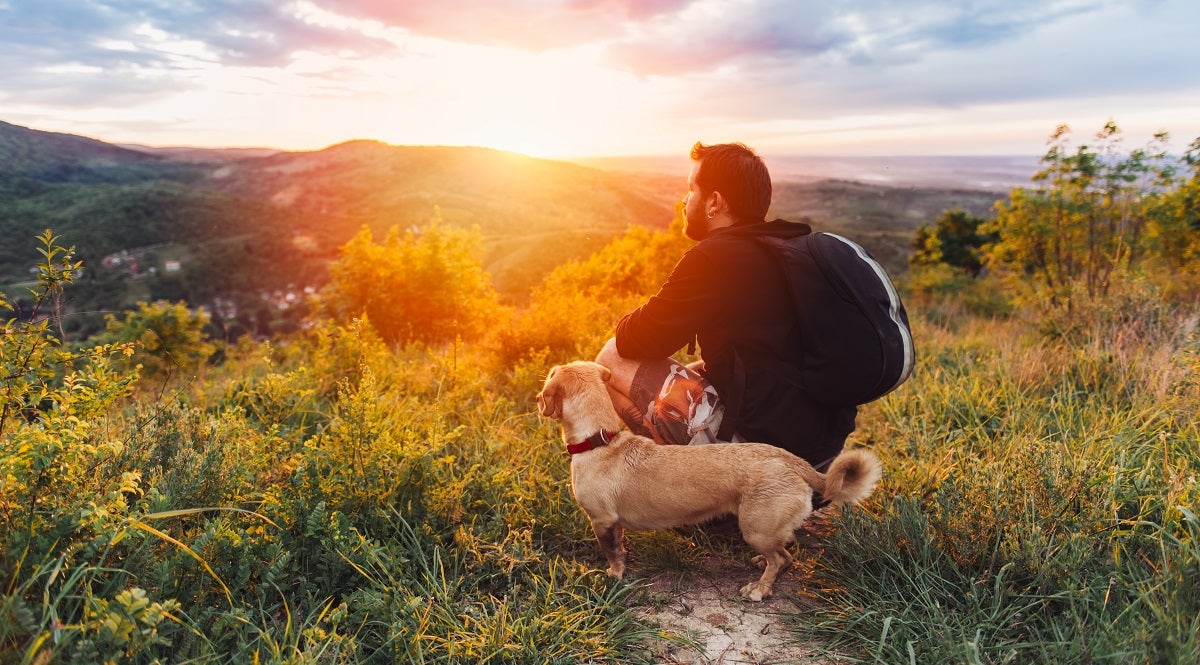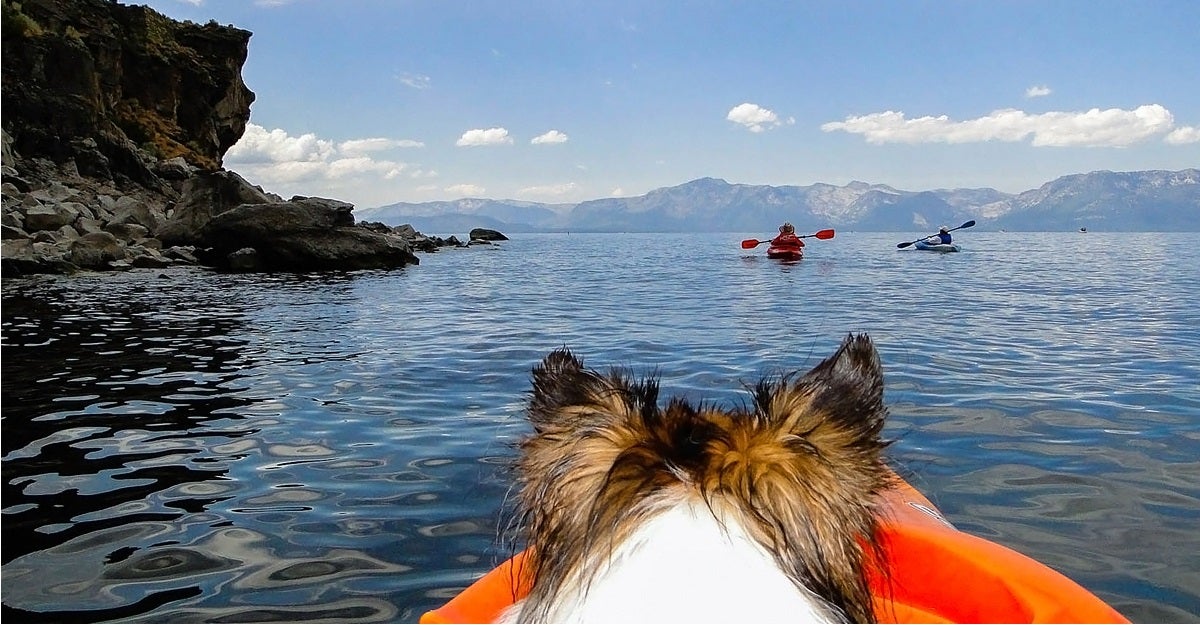
Our Editors independently research, test, and rate what we feel are the best products. We use affiliate links and may receive a small commission on purchases.
Don’t we all love getting in touch with nature? That’s why our dogs love to go outside so much. Now, you can experience the joys of camping together. Whether you’re a beginner, or you’ve camped all your life, it can be overwhelming trying to take your dog on a camping trip. But, your dog is your best friend, so why shouldn’t you take them camping with you? We’ve got the tips you need to help you and your dog on your next outdoor trip! Read on to learn how to hike and camp with your dog.
#1 Research the area you’re heading
Whether you are planning a day hike or camping in state parks, you need to do research before traveling with your dog. Some areas are not pet friendly, but a quick internet search will point you in the right direction. Most state parks are pet friendly, as long as your dog is secured on a leash.
Also, make sure that you research pet hospitals, vets, and other emergency services you might need while you are in the area on your trip. If you’re not sure if an area is pet-friendly or not you can check on BringFido for pet friendly campgrounds.
#2 Introduce your dog to your camping gear
Dogs are curious by nature, but they can get anxious when their routine changes. Before you decide to go camping, set up your tent and backpacks in the backyard. Introduce your dog to each piece of gear and the inside of the tent. Zip up the tent to see how your dog reacts. If your dog gets anxious in the tent, it might take a few days of short sessions to get your pet comfortable.
Start this process a few weeks before your trip, so you have plenty of time to get your dog adjusted. Also, make sure to do a night walk with your pet while you have flashlights or are wearing your headlamps. You can even have a trial run by spending the night with your dog in the tent in your backyard, just to make sure that everything goes smoothly.
#3 Stop by the vet before you hit the road
There are lots of critters in the woods that can be a threat to your dog. Before you trek out into the wilderness, make sure your dog is up to date on all their vaccinations. Also, ask your vet about preventative medication or products for fleas and ticks like a dog flea collar. This is also a good time to make sure that your dog’s microchip information is accurate. Finally, check to make sure your information on your dog’s tag is up to date.
#4 Pack everything your pet needs
It’s better to be prepared, but camping is tricky. Generally, you won’t have easy access to a car that you can keep running back to, so you’ll have to be smart about what you pack. You don’t want to pack too much, but you don’t want to leave anything out either. So, make a list of all the things your dog will need while you are on your camping trip. We recommend that you pack:
- Dog food
- Water or water filtration system (if you won’t have access to water)
- Dog treats
- Collapsible water and food bowls
- Dog Pick-up Bags
- Dog backpack (for your dog to wear during day hikes)
- Chew toys
- Leash (reflective collar or a clip-on light)
- Stake with lead
- First aid kit
- Blanket for tent and dog bed
- Extra towels (especially if your dog is a swimmer)
- Crate (if necessary)
- Raincoat or bad weather gear
- Shoes (depending on terrain)
Remember, you’re just now introducing your dog to camping, so you don’t have to do everything at once. Start out with an easy campsite, that isn’t a far hike. Then, move into more complicated hikes and campsites on your next trips.
If you can’t find a first aid kit, you can create your own dog first aid kit with these supplies:
- A bandana (that you can use for a muzzle)
- Tweezers and mineral oil (for tick removal)
- A blanket
- Pocket tool (you can use needle nose pliers for extracting thorns)
- Socks (to protect your dog’s feet if injured)
- A pocket sized first aid book for treating pets
- Antibiotic Ointment
- Gauze/Bandages
- Saline solution and syringe (to flush wounds)
#5 Travel at your pet’s pace
Some dogs get anxious or tired really easily, so you need to do frequent wellness checks. When traveling with your dog you’re supposed to stop every few hours, so your pet can have water and stretch their legs. Camping is no different. You should check in with your dog at the site, to make sure they’re adjusting and comfortable.
Once you choose to take your pet camping, you must stay with them at all times. So, it shouldn’t be difficult to see if they are stressed out or uncomfortable. Remember, this is all new to your pet and you need to have patience.

#6 Make sure to use your leash or a stake with a lead
You will find that most places you take your pet require them to be on a leash. Some parks are relaxed about these leash laws, but the only way to truly protect your pet is to have control of them. You never know what animals are out in the wilderness, or if there are aggressive dogs at a neighboring campsite.
It’s difficult to keep your dog on a leash when you are camping for an entire weekend, so you need to have a lead. Some campers like to stick a stake in the ground with leash attached, or they run a line between two trees. You need a way for your pet to be safe, while you are working around your campsite.
Remember, never leave your dog tied up when you aren’t around. You should only use a lead occasionally. If you don’t feel comfortable with the safety a lead, you can use a crate. However, creates are heavier, take up a lot of space, and they’re difficult to take long distances.
#7 Introduce your pet to the campsite
Once you arrive to your campsite, it’s important to show your pet around. Show your canine where their food and water bowls will be, as well as their space inside the tent. Some dogs will stick close to camp, but others are wanderers. If you know that your dog tends to run off, set your pet up on a lead as soon as possible.
A temporary solution is to loop a leash around a stake in the ground or a small tree. If you’re camping by yourself, having a dog running around can be stressful. So, you should find a safe way to restrain them while you get the rest of your campsite together.
Once everything is in place, make sure that your pet has a comfortable place to go inside the tent. A quality travel dog bed is convenient to carry with you while you’re on the road, and it’s easy to set up to give your canine a place to rest.
When you’re camping, the tent is a safe place that your pet can go to when they’re stressed out, need to sleep, or relax. You always want to give your dog a place that they feel safe, especially when they are in a totally new environment.
#8 Don’t leave food out
There are a lot of wild animals around campsites and leaving out dog food invites them into your space. So, you should feed your dog and then remove their food as soon as they are done. You should also make sure that your food is sealed up in a bag or air tight container. Smells can attract animals to your camp, which is why many campers hang their food up in a tree. So, bundle your dog’s food with your food in a safe area.
#9 Check your dog for ticks, thorns, burrs, and foxtails
Being out in the woods with your pet will introduce them to new terrain. So, your dog could be in thick underbrush that is filled with bugs, thorns, and other elements. Whenever you go out for a hike, you should keep an eye on your pet to make sure they are walking and acting normally.
Then, when you get back to the campsite, you should thoroughly check their body and paws for ticks. Your dog can easily pick up ticks in the woods behind your house, and the woods that you are camping in are no exception.
It’s important that you check your dog every night, because ticks carry diseases. Some of these diseases cause lifelong conditions that have no cure and lower your pet’s quality of life. When checking your dog for ticks pay close attention to the inside of their ears, between their toes, under their tail, near their genitals, around their eyes, and under their collar.
f you find a tick, use tweezers and grip the tick as close to the head as possible. Then, pull in an upward motion with a steady pressure. Once the tick is out, clean the area with disinfectant.
#10 Have Fun!
This is probably the most important tip on the entire list. It’s important to be safe, but it’s also important that you have a good time. Make sure to take your dog for daily hikes, so that they will be tired out by the time you get back to camp. A tired dog is a happy dog. Finally, enjoy the memories you are creating with your pup, and take lots of pictures to document your journey.

Great camping tips with your dog! Thanks for sharing.